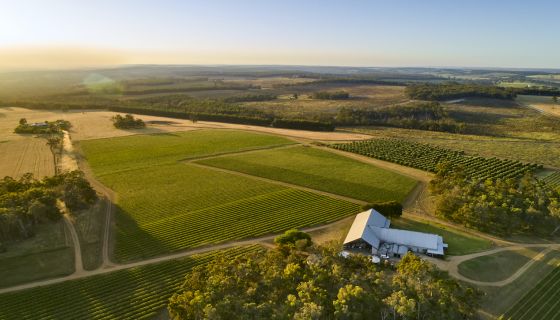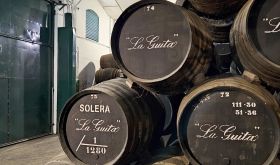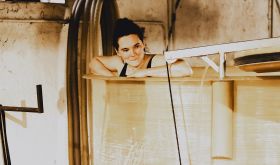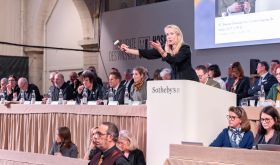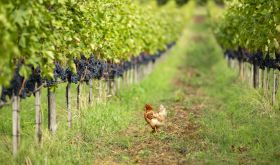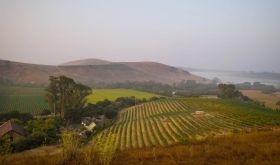Riesling from AU$25, £18.95, $27.99, 3,090 roubles
Shiraz from AU$27, £16.50, $27.99, 3,196 Japanese yen, 3,090 roubles
It’s not often I fall for a white and a red from the same source but, when tasting through new additions to the range of London wine merchant Bancroft recently, I was knocked out by the value represented by this pair. In fact, if I were a marketing person, I would say they were too good for the price.
Frankland Estate is a superb, family-run, ecologically sensitive estate in a beautiful, extremely isolated location more than 50 km (31 miles) inland from the southern coast of Western Australia. It was founded in 1988 by Judi Cullam and Barrie Smith, after they had worked a couple of vintages at Ch Sénéjac in Bordeaux. It is such a family affair in fact that their children Elizabeth and Hunter Smith also live and work on the 33-ha (82-acre) estate.
They claim ‘our approach includes organic viticulture, carefully nurturing the health of the soils in our vineyard, and only taking from our land as much as can be later replaced by natural processes. Our passion for sustainable farming was recognised in 2009 when we were awarded on organic certification.’
Although I once visited the estate, since there is no organic seal on their bottles (for complicated reasons involving satisfying the requirements of their 15 export markets, although this hurdle is to be overcome with the next vintage releases), I had forgotten all this when tasting a range of their wines recently for the tasting article From FMV to Bancroft (the Shiraz still has a Berry Bros & Rudd back label from their previous UK importer).
I tasted not just this pair of Estate bottlings but also the pair from their Isolation Ridge vineyard and, top of the range, the Riesling and Shiraz labelled Smith Cullam after the founders. They were uniformly excellent, but for value it was the regular Estate bottlings that knocked me off my feet. In fact, the first of the six wines I tasted was the Estate Riesling 2019, which is made entirely from the estate’s certified organic vineyards and is aged on lees in tank for six months; here’s what I wrote about it:
Full bottle 1,340 g. [We now try to record the weight of bottles when we can, to highlight those producers who are thoughtful enough to choose lightish bottles or thoughtless enough to prefer heavy ones; see Bottle weight – the goodies and baddies.]
Pure lime and grassy herbs on the nose – tarragon? Lime fruit and great powdery finish. If this is the entry-level Riesling, what the heck are the other ones going to be like?! Very much Great Southern style of Riesling, which is so distinctive and so delicious. Dry but not remotely austere. GV 16.5/20 13.5% Drink 2020–2025 £19 Bancroft Wines
I’ve long thought that the style of Riesling made in this corner of Western Australia is particularly distinctive – dry, confident and with a certain grassy/herby quality such as those of Alkoomi. This Frankland Estate wine did not disappoint in that respect. Frankland Estate has always been Riesling-centric. As Hunter Smith pointed out in an email recently:
‘Riesling has been a huge part of Frankland Estate from the very beginning, starting with Judi and Barrie drinking local examples in the 1970s and 1980s, prompting them to plant Riesling vines. Over the following decades their unwavering determination helped build the Riesling profile through International Riesling Tastings and Riesling scholarships offered to the Australian trade. An unexpected benefit is the undeniable comradery and friendships formed with fellow Riesling producers around the globe that have not only been equally enthusiastic to help promote the varietal but undeniably generous with their knowledge about Riesling, influencing how we view and make our wines today. Riesling equates to just over 2% of Australia’s planted area but more than 40% of Frankland Estate’s annual production.’
I had the pleasure of attending the 2012 Frankland Estate International Riesling Tasting in Sydney and it was truly a great, serious international affair. Remember when we were all able to meet up and taste together?
Shiraz is the estate’s other preoccupation and indeed more than 80% of production is either Riesling or Shiraz, in very much Syrah style. In recognition of this they plan to label Isolation Ridge and Smith Cullam bottlings Syrah from the 2018 vintage while retaining the familiar Shiraz for the Estate bottling. Here’s my note on the Estate Shiraz 2017:
Full bottle 1,250 g. Entirely from the estate's certified organic vineyards, fermented in open fermenters and matured in 500-litre puncheons for 12 to 14 months. Contains 20% of the new clones planted (470 and 174) making up a total of 99% Shiraz and 1% Viognier.
Bright crimson. Very clean and peppery with sweet fruit but real energy. Like the entry-level Riesling, this is a star! So obviously Syrah (rather than Shiraz) and really fresh and refreshing without being tart. Probably not for the long term but really delicious now. Quite long! VGV 16.5/20 14.5% Drink 2020–2024 £19 Bancroft Wines
I loved the purity of this 2017 Estate Shiraz and Hunter explained how, not just their organic techniques in the vineyard, but their use of shallow open-topped fermenters has given them control over tannin management, while ageing in larger puncheons and foudres helps retain freshness in their various Shirazes. The original plant material came from the estimable Houghtons in 1988 but they are delighted with the results of grafting over some of the old vines to new clones 470 and 174.
I honestly think any fan of northern Rhône Syrah would not be disappointed in this Estate Shiraz. It’s certainly light years from stereotypical Barossa Shiraz, but then it was made a 28-hour drive away.
I’ve long been sceptical about pairs of wine – a red and a white – that are priced identically. It’s usually more expensive to make the red than the white, meaning that the white tends to be overpriced – or the red underpriced. I think that is true of this pair: the red, with its extra two years’ maturity, is an even better deal than the white – especially when you look at the minimum prices for each above.
Seize these bargains while you may. Australian wine exports need all the help they can get now that the Chinese have effectively stopped importing Australian wine. Both wines are available in Australia, the UK and Russia, and the Shiraz also in Japan. Wine-Searcher does not yet show any US retail stockists but I am assured by the new importer Vinedos Imports that both Wine Exchange in Santa Ana, California, and K & L in San Francisco will soon have stock of both these wines at around $28.
Find out more about the wines of Western Australia on JR.com

